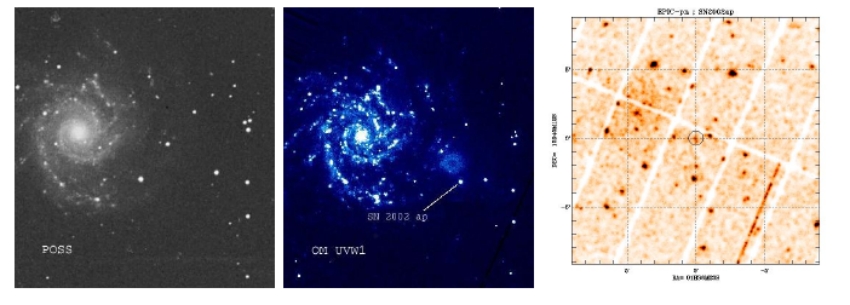
 Credit: ESA and XMM-Newton SOC
Credit: ESA and XMM-Newton SOC
Death of a Faraway Star
In January of this year a titanic explosion rocked a distant galaxy M74.
The explosion occurred in January 2002 (though in reality the explosion
occurred 20 million years prior to January 2002, since the galaxy is about
20 million light years from earth). This explosion is suspected by some
astronomers to represent a so-called "hypernova", the complete destruction
of a star and one of the most powerful explosions known to exist. Such
explosions play a role in shaping
galaxies, in producing complex chemicals, and in triggering new star
formation, and so understanding how they happen provides astronomers with
a key to understanding the evolution of galaxies and the Universe. Now
astronomers have a new piece of vital evidence, since the XMM-Newton X-ray
observatory managed to observe SN 2002ap
ust a few days after discovery
and to image the explosion using its ultraviolet and X-ray cameras.
The image above left shows a Palomer Sky Survey image of M74 prior to the
explosion. The middle image shows the XMM-Newton UV image of the supernova
obtained with the Optical Monitor. The location of the supernova is marked
by an arrow. The image on the right shows an X-ray image of the supernova
obtained by the XMM-Newton EPIC/PN camera. The supernova's position is marked
by the circle. Astronomers can use the XMM-Newton observation to help
identify the type of star that exploded, and to understand how the
fireball expands into the galaxy.
Last Week *
HEA Dictionary * Archive
* Search HEAPOW
* Education
Each week the HEASARC
brings you new, exciting and beautiful images from X-ray and Gamma ray
astronomy. Check back each week and be sure to check out the HEAPOW archive!
Page Author: Dr. Michael F. Corcoran
Last modified March 11, 2002


